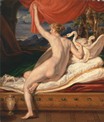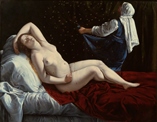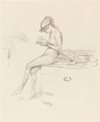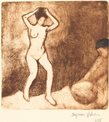









Two large paintings
Images below are in chronological order and sized approximately to scale relative to each other. *Click images to enlarge*
1. Venus rising from her couch
Artist: James Ward, age 59 (British, born 1769, died 1859)
Medium: Oil on panel, 30 x 26 inches
Location: Painted in London
Time: Painted in 1828, during the reign of King George IV. Ward's wife and daughter had died in 1821. Two years after painting this work, Ward withdrew from London and moved to the country with his second wife. Ward was a member of the Royal Academy of the Arts (RA). The institution assisted him financially in his final years.
Woman subject: Venus is the Roman goddess of love and beauty.
Things to notice: Ward is known for painting animals. He also did portraits, landscapes, and history paintings. This history painting incorporates all of these elements. The swans symbolize Venus and represent love and beauty. The pair of doves at the foot of the bed are also metaphors for Venus. Notice Venus' elongated torso. Ward was a proponent of Romanticism. His portrayal of Venus is frankly sensual, in keeping with a long tradition in Western art of eroticizing depictions of the female nude for the appreciation of the male gaze.
2. Nude figure
Artist: Ernst Ludwig Kirchner, age 27 (German; born 1880, died 1938)
Medium: Oil on canvas, 77 x 26 inches
Location: Painted in Dresden
Time: Painted in 1907, two years after Kirchner formed the artists' group Die Brücke ("The Bridge") in Dresden. Kirchner would join the army at the onset of World War I. However, he was soon discharged due to a mental breakdown. Kirchner immigrated to Switzerland after leaving the army. Later, the Nazis considered Kirchner a "degenerate artist" and confiscated and destroyed his works, contributing to his suicide.
Woman subject: The identity of the subject is unknown. She is probably a studio model.
Things to notice: Kirchner is considered an Expressionist artist. His group Die Brücke sought to connect Primitivist art and the actual art of indigenous peoples to a future unified style of art. Kirchner's use of flat areas of color and simplified forms are characteristic of Expressionism and Die Brücke aesthetics. Notice how the woman's contorted arms create the effect of distorted perspective. Compare this painting side-by-side to the painting by Ward done only 79 years previously. How are the paintings similar? How do they differ? What do they tell you about the relationship between the female body and aesthetics in art?
Smaller works
Images below are in chronological order and sized approximately to scale relative to each other (two times the scale of the images above). *Click images to enlarge* (enlargement disabled for Danaë)
3. Woman
*Gender of artist is unknown*
Artist: Artist unknown (Iranian)
Medium: Ceramic sculpture, 14.8 inches tall
Location: Made in western Iran
Time: Made around 1300 B.C. to 800 B.C., during the Middle Elamite Period.
Woman subject: This piece may have some functional purpose as well as serving as an image of fertility and prosperity. The image may represent a female deity responsible for abundant crops and healthy livestock.
Things to notice: This simplified red clay figure with emphasized hips reflects a prehistoric aesthetic. The pointed head differs from the typical Elamite bulging hairstyle but is evident in other ceramic sculpture from this region and period.
4. Female figure
*Gender of artist is unknown*
Artist: Artist unknown (Mexican)
Medium: Earthenware sculpture, burnished slip paint, 15.7 x 7 x 2.8 inches
Location: Made in Mexico, possibly Puebla or Morelos
Time: Made around 1200 B.C. to 900 B.C. during the Early Formative Period in Mesoamerica. Village communities were agricultural and were developing improved cultivation methods.
Woman subject: Hollow figures like this one are found in Mexican burial sites. The female figure may represent fertility or may depict a religious shaman.
Things to notice: The figure's hands and feet are crudely represented, her legs are disproportionally short, and her arms are non-existent. This emphasis on the woman's core may indicate she symbolizes the concepts of fertility and abundance. However, her enormous head and headdress, wide eyes, and open mouth suggest a shaman in a trance. In Pre-Columbian Middle American culture, women and men both functioned as shamans. View the two sculptures side-by-side. How do the artists' distortions of the female body communicate their ideas?
5. A young daughter of the Picts
Artist: Jacques Le Moyne de Morgues, age about 52 (French; born about 1533, died before 1588)
Medium: Drawing, watercolor and gouache, touched with gold on parchment, 10.2 x 7.4 inches
Location: Made in London
Time: Made around 1585, five years after Le Moyne immigrated to England. This drawing is a model for an engraved illustration in the book Briefe and True Report of the New Found Land of Virginia published by Theodor de Bry in 1590. It is included in a chapter comparing the aboriginal people of Great Britain to the Native Americans in the New World.
Woman subject: The Pictish kingdom existed in what is now northeastern Scotland from about the 3rd century. The Picts came under the rule of the king of Scots in the 9th century. Body tattooing was a custom of the Picts. The young woman holds a spear and carries a sword chained to a belt around her naked waist.
Things to notice: Le Moyne was known for his ethnological illustrations -- especially of Florida's Timucua Indians -- and for his botanical drawings. He had served as the artist on a French expedition to Florida when he was about 31 years old. In this drawing, Le Moyne has included some new plant species among the woman's tattoos as a way of showcasing his botanical knowledge, even though those species would not have existed in western Europe during the time of the Picts.
6. Danaë
*Woman artist*
Artist: Artemisia Gentileschi, age about 19 (Italian; born 1593, died 1652 or 1653)
Medium: Oil on copper, 16 1/4 x 20 3/4 in. (41.3 x 52.7 cm) (framed: 26 x 30 x 4 in. (66 x 76.2 x 10.2 cm))
Location: Painted in Rome or Florence
Time: Painted in about 1612, around the time that she was the plaintiff in a public rape trial. Gentileschi had been raped by her painting teacher, Agostino Tassi. He refused to marry her (the conventional remedy for lost virginity, even in circumstances involving sexual assault), claiming that she wasn't a virgin. Gentileschi's father took Tassi to court to clear his daughter's name. The Gentileschis won the case, but in the end Tassi was released from prison without serving his punishment of exile. Gentileschi was married off to a Florentine painter.
Woman subject: Danaë is a character in Greek mythology, the daughter of King Acrisius of Argos. After receiving a prophecy that a child of Danaë would kill him, Acrisius isolated Danaë in a locked room to prevent her from having sex. But the god Zeus was able to circumvent Acrisius by taking on the form of a shower of gold. In this guise, he impregnated Danaë with a son, Perseus. Perseus eventually killed Acrisius in a discus-throwing accident.
Things to notice: Gold coins are raining down upon Danaë and accumulating between her legs. Her right fist tightly clutching a handful of coins creates a mood of tension, but the posture of her slightly arched back and her raised arm suggest sexual pleasure. Gentileschi typically depicts her female subjects as complex and assertive rather than passive. Strong and active hands -- like Danaë's clenched fist in this work -- are hallmarks of Gentileschi's heroines.
Additional information: Gentileschi's father, Orazio, was a painter. Orazio trained Gentileschi to paint in his style and execute some of his workshop commissions before she became Tassi's pupil and victim. Gentileschi refused to limit herself to portraits and still lifes. She became a recognized and successful history painter in the Baroque style, active in Rome, Florence, and Naples. She was the first woman artist to join the Accademia del Disegno. Gentileschi is known for her depictions of strong, powerful women. Some art historians believe that Gentileschi's experience of sexual violence influenced her portrayals of women. In any case, her paintings of heroines differ from works on the same subjects by male artists, reflecting her different perspective on women in society.
7. Woman at the bath with a hat beside her
Artist: Rembrandt van Rijn, age 52 (Dutch; born 1606. died 1669)
Medium: Etching and drypoint, 6.2 x 5.0 inches
Location: Made in Amsterdam
Time: Printed in 1658, during a difficult period in Rembrandt's life. Despite his former success as a sought-after history painter and portraitist, Rembrandt had declared bankruptcy two years earlier, sold his large, expensive house, and moved to a small rental in an artists' quarter. He was living with Hendrickje Stoffels and their child. Rembrandt was unable to marry Stoffels due to a provision in his dead wife's will that he would need to give half of their estate to their son: money he no longer had. Rembrandt's etchings from about this point onward focused exclusively on the female nude.
Woman subject: The identity of the subject is unknown. She is probably a studio model.
Things to notice: Rembrandt is known for his use of tone in his etchings. Notice how the woman's left hand almost disappears into the shadows. The scratch-like lines and patches of black are hallmarks of the drypoint technique. This genre scene depicts the female nude with sensitivity and dignity as opposed to sensualizing her in a voyeuristic way.
8. The little nude model, reading
Artist: James McNeill Whistler, age 55 (American; born 1834, died 1903)
Medium: Lithograph on grayish ivory chine mounted on ivory plate paper, 8.9 x 7.2 inches
Location: Made in London
Time: Printed in 1889 or 1890, toward the end of Whistler's tumultuous career. Whistler had finally achieved an international reputation, but ten years earlier he had declared bankruptcy. At the time he had lost commissions due to publicity over a libel case. Whistler eventually won the case in principle, but he wasn't awarded any damages.
Woman subject: The identity of the model is unknown.
Things to notice: Whistler's lithographic style is similar to a chalk drawing. Notice the contrast in definition provided for the model -- the firmness of the lines and the shading -- compared to her environment, which trails off without a definitive border. The mark on the face of the cabinet or chest of drawers is Whistler's "butterfly" signature, a highly stylized version of his initials (JW). In this genre scene, Whistler depicts the female nude as an independent person engaged in the introverted and intellectual act of reading.
9. La toilette
*Woman artist*
Artist: Suzanne Valadon, age 30 (French; born 1865, died 1938)
Medium: Softground etching and etching with monotype wiping in brown and black on Van Gelder Zonen laid paper, 8.9 x 8.8 inches
Location: Made in Paris
Time: Printed in 1895, the year before Valadon married a wealthy stockbroker and consequently was able to quit working and concentrate on her own painting. She worked as an artists' model. She also had learned etching from Edgar Degas the year before, to generate additional income. However, she only made about thirty prints.
Woman subject: The identities of the subjects are unknown.
Things to notice: Valadon is known for portraying women in unidealized and unsensational ways, as specific individuals in the midst of a particular moment. The woman at the right pours water from a pitcher into a basin for the standing woman to use to wash up. Notice the unaffected posture of the bathing woman. The monotype technique is effectively used to visually segment the print into areas of tone. Notice the selective use of black ink solely on the secondary woman's hair.
Additional information: Valadon was the only child of a single mother who supported them by working as a maid. A self-taught artist who started drawing when she was 9 years old, Valadon began modeling for artists at 15. She was a mother by the age of 18. The paternity of her son Maurice Utrillo, also an artist, is not known. Valadon eventually married a stockbroker, then divorced him to marry a painter who served as her model. Free from the codes of respectability, Valadon specialized in the female nude. She set her subjects in familiar and banal circumstances in which their nudity was natural and appropriate. Valadon did not gain recognition as an artist until the 1920s.
10. Woman washing her face
Artist: Hashiguchi Goyo, age about 40 (Japanese; born about 1880, died 1921)
Medium: Woodcut print on paper, 21.9 x 16.9 inches
Location: Made in Japan
Time: Printed in 1920, the year before Goyo died. Goyo was part of the shin-hanga movement in the early 20th century to revive the tradition of ukiyoe prints.
Woman subject: The identity of the subject is unknown.
Things to notice: Goyo is known for his demure yet sensual depictions of women. The device of the screen provides a psychological suggestion of discretion even though it is transparent. Notice the delicate lines forming the woman's hair and eyelashes. The almost monochromatic palette is punctuated by restrained splashes of vivid red and pale yellow and the rich blackness of the woman's hair. The flat outline shape of the woman's figure is typical of Japanese prints. Compare the three prints depicting women bathing side-by-side. How does the middle print, made by a female artist, differ from the other two prints, made by male artists?
Image sources:
1. Ward, James. Venus rising from her couch. Painting. Yale Center for British Art. New Haven. 31 Oct. 2013. http://britishart.yale.edu/
2. Kirchner, Ernst Ludwig. Nude figure. Painting. National Gallery of Art. Washington. 14 Nov. 2013. https://images.nga.gov/
3. Woman. Sculpture. Los Angeles County Museum of Art (LACMA). Los Angeles. 1 Nov. 2013. http://www.lacma.org/
4. Female figure. Sculpture. The Walters Art Museum. Baltimore. 5 Nov. 2013. http://thewalters.org/
5. Le Moyne de Morgues, Jacques. A young daughter of the Picts. Drawing. Yale Center for British Art. New Haven. 9 Dec. 2013. http://britishart.yale.edu/
6. Gentileschi, Artemisia. Danaë. Painting. Saint Louis Art Museum, object no. 93:1986. Museum Purchase and gift of Edward Mallinckrodt, Sydney M. Shoenberg Sr., Horace Morison, Mrs. Florence E. Bing, Morton D. May in honor of Perry T. Rathbone, Mrs. James Lee Johnson Jr., Oscar Johnson, Fredonia J. Moss, Mrs. Arthur Drefs, Mrs. W. Welles Hoyt, J. Lionberger Davis, Jacob M. Heimann, Virginia Linn Bullock in memory of her husband, George Benbow Bullock, C. Wickham Moore, Mrs. Lyda D'Oench Turley and Miss Elizabeth F. D'Oench, and J. Harold Pettus, and bequests of Mr. Alfred Keller and Cora E. Ludwig, by exchange
7. Rembrandt van Rijn. Woman at the bath with a hat beside her. Print. National Gallery of Art. Washington. 4 Nov. 2013. https://images.nga.gov/
8. Whistler, James McNeill. The little nude model, reading. Print. National Gallery of Art. Washington. 1 Jan. 2014. https://images.nga.gov/
9. Valadon, Suzanne. La toilette. Print. National Gallery of Art. Washington. 5 Nov. 2013. https://images.nga.gov/
10. Goyo, Hashiguchi. Woman washing her face. Print. The Walters Art Museum. Baltimore. 15 Nov. 2013. http://thewalters.org/